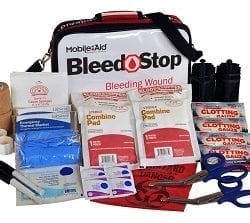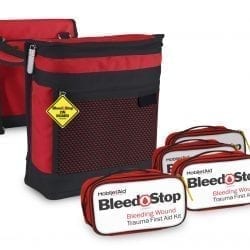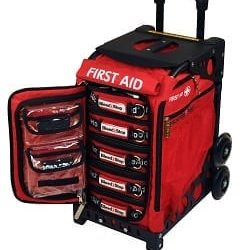Content Warning: This article contains descriptions of severe injuries and may not be suitable for all readers.
In a tragedy, first responders can help victims by stopping uncontrollable bleeding before medical professionals arrive. Bystanders can often make the difference between life and death with the help of a bleed control kit.
We have compiled a list of users’ common questions about using a bleed control kit for the first time. The more people know the proper techniques to Stop The Bleed, the more lives will be saved when tragedy strikes.
Where Can I Get Training on How to Use a BleedStop Kit?
To familiarize yourself with the items in your kit, you should take a course online or in your community. The official Stop The Bleed website offers various resources to help and a complete online course.
For more online resources, Stop The Bleed provides instructional posters and flowcharts to hang around the workplace and home.
Also, your local fire department, emergency medical services agency, or community outreach department at your local hospital may offer in-person courses.
When Should I Use a BleedStop Kit?
To identify whether or not you should use a BleedStop kit, you must determine if the wound is life-threatening.
Here are six potential identifiers that a wound needs a BleedStop kit:
- Blood spurting out of the wound
- Blood that won’t stop coming out of the wound
- Blood that is pooling on the ground
- Clothing or bandages are soaked with blood
- Loss of all or part of an arm or leg
- Bleeding victim is confused or unconsciousness
If you identify any of these situations, time is of the essence, and your actions can directly result in whether or not they survive. Knowing and understanding when and how to use a BleedStop kit helps save lives.
How Do I Use a BleedStop Kit?
If you’ve never used a BleedStop kit before, it is recommended that you take online or in-person training before use.
In the case of an emergency when you haven’t yet been trained, here are the steps you need to take to help save a life using a BleedStop kit:
- Calmly call 9-1-1 to report the incident, and ensure your safety before jumping in to help a victim.
- Approach the victim and identify the source of the bleeding.
- Wear gloves (if available) to protect yourself from blood-borne infections.
- Determine if the bleeding is life-threatening.
- Apply a tourniquet to life-threatening injury (see more info below about applying a tourniquet).
If you’ve identified the bleeding as life-threatening and coming from an arm or leg, there may be a tourniquet in the kit to wrap around the bleeding site.
If a tourniquet is unavailable, pack the wound with gauze or a clean cloth and apply pressure with both hands until relieved by medical professionals.
The main objective is to compress the bleeding blood vessel to stop blood flow until paramedics or emergency service providers arrive – the items in your kit are designed to help you.
How Can I Monitor the Victim’s Condition?
In a course on the proper use of a bleeding control kit, you will also learn how to monitor the victim’s condition as pressure is being applied to the bleeding site.
You’ll want to observe any signs of confusion or unconsciousness of the bleeding victim and check for vital signs until professionals arrive.
How Long Does it Take for a BleedStop Kit to Work?
Depending on the severity of the wound, a BleedStop kit can work in as quickly as a few seconds. Some wounds may require more serious medical attention, but a BleedStop kit works well until the paramedics arrive.
What Should I Do While Waiting for the Paramedics to Arrive?
The first rule for using a BleedStop kit is to remain calm.
Not only do you want to stop the flow of blood, but you also want to keep the victim calm. Keep the victim stationary and ensure their alertness by continually speaking to them.
Stop The Bleed with LifeSecure
Every commercial building needs a BleedStop kit and a handful of trained employees. LifeSecure offers a wide range of comprehensive Bleeding Control Kits with everything you need to save lives during an emergency.







